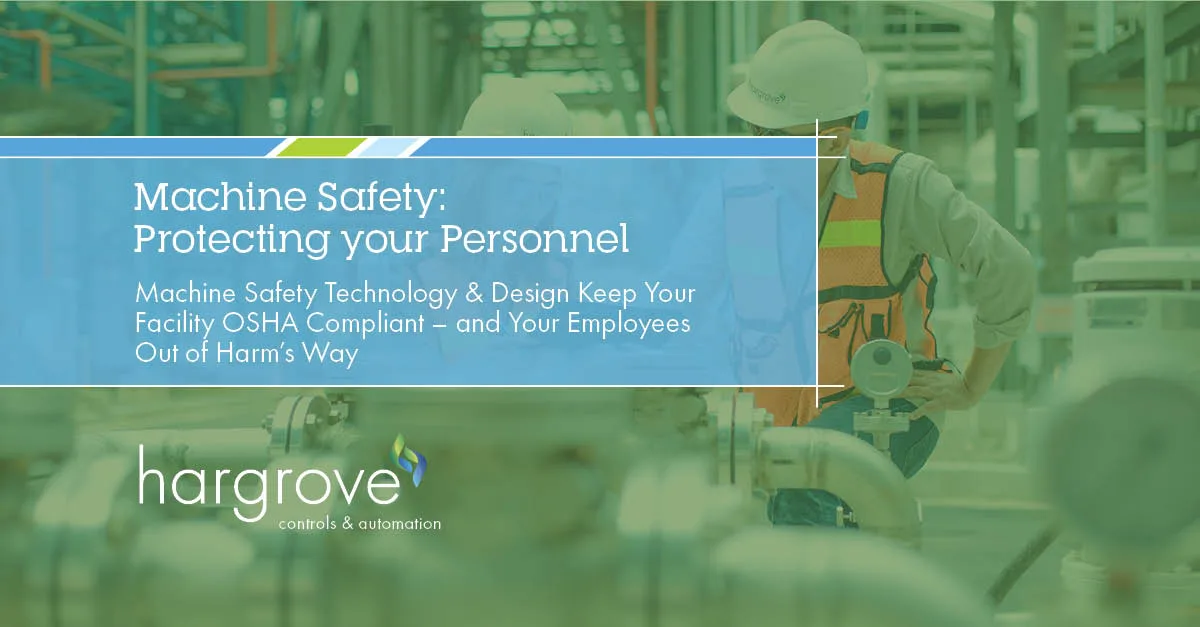Machine Safety: Protecting your Personnel

Plant managers are rightfully concerned about safety. Slips, trips, falls, and fire protection are common areas of safety in the industry. However, have you considered other hazards at your site, such as pinch points, hazardous materials, or rotating equipment? All of these carry inherent risk for injury to your personnel.
Addressing machine safety shouldn’t be an afterthought. Learn more about machine safety to gain peace of mind, protect your people, and comply with the Occupational Health and Safety Administration (OSHA) and other industry standards.
Comply with OSHA and Industry Standards
OSHA’s general duty clause (Part 1910, Section 5) establishes the expectations and legal requirements for employers to provide personnel with a place of employment that is free from recognized hazards.
The National Fire Protection Association (NFPA) 70E Standard for Electrical Safety in the Workplace is a critical standard for both Europe and the United States. The American National Standards Institute (ANSI) standards and the Machine Directive 2006/42/EC are for European standards to acquire the Conformité Européenne (CE) mark. Depending on your location, there are certain International Organization for Standardization (ISO) standards that you’ll also need to consider.
These standards are a collection of proven engineering practices that provide guidance and methods to comply with safety regulations.
The Functional Safety Management approach uses the safety lifecycle and delivers an iterative method for producing a viable system that satisfies the requirements defined in the U.S. Regulations and EU Directives.
The Functional Safety Lifecycle
The Functional Safety Lifecycle provides a plan of action for ongoing efforts to meet the required level of safety at your facility throughout the machine’s lifecycle.

The first step in the safety lifecycle is the identification and assessment of all potential and current hazards (mechanical, electrical, chemical, thermal, or environmental) that could be associated with the machine.
Questions to consider during this phase include:
- Is the machine harmful to personnel?
- What is the probability of injury?
- How often will personnel be exposed to the hazard?
The risk is quantified with a number from industry standards such as ISO and ANSI standards. If the number is too high, safety functions must be implemented to the reduce risk of injury. Completing a risk assessment allows you to understand your rating and devise a safety plan moving forward.
As you progress through the safety lifecycle, the design, verification, and installation stages help introduce safety measures and mitigate risk. Can the hazard be designed out of the machine? Does the required Performance Level and Safety Integrity Level (PL/SIL) meet the calculated PL/SIL? If not, adjustments must be made, or the risk must be re-evaluated. Validation requires that the safety system is functioning the way it was intended.
Reduce Risks and Mitigate Hazards
The risk reduction of machines can be implemented in three different ways.
Prevention
To prevent a hazard, the machine’s design can be modified to inherently reduce risk. Safety design measures, like changing the shape or size of the equipment, can also reduce the chance of injury and eliminate a pinch point.
Control
To control a hazard, safeguards or other complementary protective measures like e-stops are implemented. The easiest method of achieving a controlled hazard is installing a barrier in front of the machine to prevent access.
Indication
To indicate a hazard, display clearly marked signs in the area and provide information to personnel so they are aware of the hazard. This method must account for human error.
The safest system is one that is running as planned and has engineered out room for human error as much as possible.
Machine Safety Strategies
Below are a few strategies that you can implement at your facility to create a safer working environment.
Display Signage
Mark dangerous areas and ensure that everyone working around that area is properly trained. Make signage clear and visible. For instance, paint a floor area yellow to indicate a hazard is present.
Test Equipment
Older equipment can become hazardous to personnel. A machine that was safe ten years ago is most likely not up to date. Test the machine to determine if the safety systems you have in place are operating properly. When you hit an e-stop, does it stop production? Does the machine need to be re-engineered or replaced?
Enforce Safety
You may have already conducted a risk assessment in the past and placed safety controls in designated areas. Are the safety controls being followed properly? Have safeguards been removed from rotating equipment? Are your personnel working behind guards while the machine is running? Create a culture of safety. Reinstall guards. Train personnel.
Ensure a Safe Working Environment
Even if your plant has a simple process, it can still be hazardous to your personnel. A risk assessment can identify the obvious hazards – pinch points – as well as any indirect hazards.
Hargrove Controls & Automation’s Team will walk through your facility to identify and assess potential hazards and formulate a cost-effective solution for your plant. Our Team is committed to keeping your people and property protected.
Don’t be in violation of the law. Address hazards at your facility. Get your facility OSHA compliant. To learn more about Hargrove’s machine safety capabilities, visit our website.

